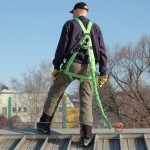Cable Versus Fixed-Track Lifelines: What Is The Difference?
 Fall arrest systems are designed as a safety backup mechanism when a worker must be exposed to a fall hazard in order to accomplish assigned tasks. When the worker needs to be able to move along either a horizontal or vertical plane, lifelines are used to protect the worker. The lifelines can be constructed using either cable or fixed-track.
Fall arrest systems are designed as a safety backup mechanism when a worker must be exposed to a fall hazard in order to accomplish assigned tasks. When the worker needs to be able to move along either a horizontal or vertical plane, lifelines are used to protect the worker. The lifelines can be constructed using either cable or fixed-track.
Cable vs. Fixed Track
- Cable systems, as the name implies, are composed of steel wire rope strung between two end anchorage points, and may contain one or more intermediate anchors, depending on the length.
- Fixed Track systems utilize a rigid rail that typically encloses a trolley inside a formed channel.
Horizontal vs. Vertical
- Horizontal systems are generally installed along rooftops, catwalks and other elevated work surfaces constructed over machinery or chemical vats. They can be used for either fall restraint or fall arrest.
- Vertical systems are most commonly installed to allow workers to climb exterior or interior fixed ladders safely.
Fall arrest in horizontal and vertical scenarios must be handled differently, based on the distinguishing nature of each. In horizontal systems, the potential forces are perpendicular to the line, creating tremendous force on the endpoint anchors of flexible lines, whereas the forces in vertical systems are generally in the same direction as the line, resulting in significantly lower force on the anchorages.
A Pro/Con Snapshot Of Cable Versus Fixed-Track
Cable Pros:
- Lower cost
- Continuous 100% pass-through tie off
- Flexible design
- Very efficient for longer lifeline lengths
Cable Cons:
- Higher fall clearance needed due to cable stretch
- Greater forces experienced at endpoint anchorages
- System activation usually leads to major component replacement
- All parts are exposed to the elements
Fixed-Track Pros:
- Lower fall clearance needed
- Continuous 100% pass-through tie-off
- Design allows for protection from outside elements
Fixed-Track Cons:
- Higher cost
- Design options may be limited or cost prohibited
- System activation usually leads to major component replacement
There are fall hazards that exist when a cable lifeline system is going to be a more effective solution than fixed-track lifelines (and vice versa). Cable is better for elevated work surfaces with a higher fall clearance, while fixed-track is more suitable for lower fall clearance work areas.
Before installing fall protection in your facility, it’s always best to first consult with an expert who has the experience and knowledge to conduct on-site assessment and determine the safest and most cost-effective solution to install.
Ready to learn more about installing the right fall protection in your facility? Call us below.

